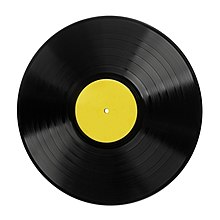Long-play
 |
|

A 12 inch LP vinyl record
|
|
| Media type | Audio playback |
|---|---|
| Encoding | Analog groove modulation |
| Capacity | Originally 23 minutes per side, later increased by several minutes, much longer possible with very low signal level |
| Read mechanism | Microgroove stylus (maximum tip radius 0.001 in or 25 µm) |
| Dimensions | 12 in (30 cm), 10 in (25 cm) |
| Usage | Audio storage |
| Extended from | 1948 |
| Extended to | Present |
The LP (from "long playing" or "long play") is an analog sound storage medium, a vinyl record format characterized by a speed of 33 1⁄3 rpm, a 12 or 10 inch (30 or 25 cm) diameter, and use of the "microgroove" groove specification. Introduced by Columbia in 1948, it was soon adopted as a new standard by the entire record industry. Apart from a few relatively minor refinements and the important later addition of stereophonic sound, it has remained the standard format for vinyl albums.
At the time the LP was introduced, nearly all phonograph records for home use were made of an abrasive (and therefore noisy) shellac compound, employed a much larger groove, and played at approximately 78 revolutions per minute (rpm), limiting the playing time of a 12-inch diameter record to less than five minutes per side. The new product was a 12- or 10-inch (30 or 25 cm) fine-grooved disc made of vinyl and played with a smaller-tipped "microgroove" stylus at a speed of 33 1⁄3 rpm. Each side of a 12-inch LP could play for more than 20 minutes. Only the microgroove standard was new, as both vinyl and the 33 1⁄3 rpm speed had been used for special purposes for many years, as well as in one unsuccessful earlier attempt to introduce a long-playing record for home use by RCA Victor.
Although the LP was suited to classical music because of its extended continuous playing time, it also allowed a collection of ten or more pop music recordings to be put on a single disc. Previously, such collections, as well as longer classical music broken up into several parts, had been sold as sets of 78 rpm records in a specially imprinted "record album" consisting of individual record sleeves bound together in book form. The use of the word "album" persisted for the one-disc LP equivalent.
The prototype of the LP was the soundtrack disc used by the Vitaphone motion picture sound system, developed by Western Electric and introduced in 1926. For soundtrack purposes, the less than five minutes of playing time of each side of a conventional 12-inch 78 rpm disc was not acceptable. The sound had to play continuously for at least 11 minutes, long enough to accompany a full 1,000-foot (300 m) reel of 35 mm film projected at 24 frames per second. The disc diameter was increased to 16 inches (40 cm) and the speed was reduced to 33 1⁄3 revolutions per minute. Unlike their smaller LP descendants, they were made with the same large "standard groove" used by 78s.
...
Wikipedia
